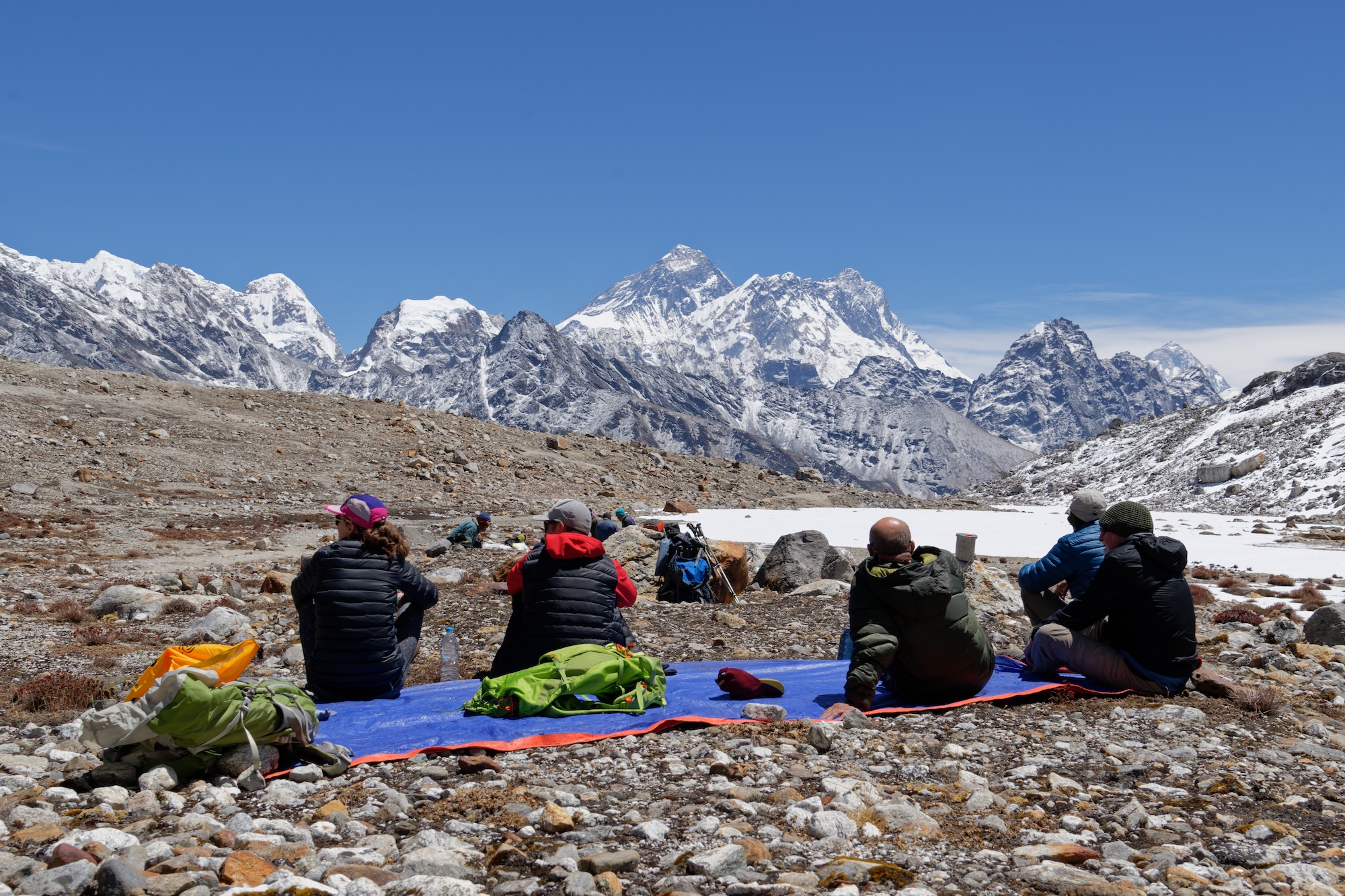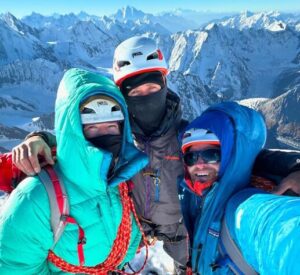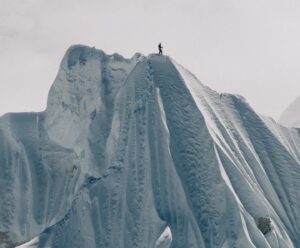Nepal’s Solukhumbu isn’t all crowds and helicopters. Away from the Everest Base Camp trail, it still feels suitably wild. There are alpine mammals, alleged Yeti sightings, and perhaps the world’s greatest long-distance hiking route, The Great Himalaya Trail (GHT).
You can catch up with Part I of my trip with World Expeditions here.
Gokyo Ri
Above the village of Gokyo, from Gokyo Ri, you get perhaps the best view of Everest without climbing a major peak. The trek up is brief but unrelenting, a one to three-hour slog depending on your fitness, ascending from 4,750m to 5,357m.
Heading up to catch the dawn, I saw a sherpa guide carrying up an exhausted (at a guess) 12-year-old and a mother trying to coax a child onward who could not have been more than five. A handful of trekkers seemed to be struggling with the altitude. Later, a helicopter arrived to airlift out a trekker who had fallen on the descent.
At the top, the sun rose directly over Everest and Lhotse. To the north, Cho Oyu feels close enough to touch.

Sunrise over Everest from Gokyo Ri. Gokyo village is on the edge of the lake in the bottom right. Photo: Martin Walsh
Renjo La
The next day involved trekking back up to roughly the same altitude, the 5,360m Renjo La. The third pass of the Three Passes route, it’s a spectacular day. We were lucky with the weather. It had snowed the previous night but most of it had melted by the time we were climbing the steepest sections.
Just below the saddle of the pass, we stopped for lunch. Having now merged our small group with the three Australian trekkers hiking the full 150+ day GHT with World Expeditions, our team was substantial and felt like a major expedition. A flat area without snow quickly transformed into a makeshift kitchen, where vegetables were diced and the ubiquitous Nepali black tea brewed.
The food during the tour was surprisingly varied. I expected to survive on a diet of almost exclusively dhal bhat (dhal and rice) but had been treated to chapatis, tuna, salami, spaghetti, and even pizza during our trek. Now, at well over 5,000m, we were served a three-course meal including a starter soup, curry, and fresh fruit for dessert.
After digesting, we packed up and marched off, the two ultra-fit French Canadians leading the way. The three Australians, Roger, Mal, and Allan, brought up the rear with a second guide. Their mammoth trek necessitated a slow and steady approach. A third of the way through their traverse, their endurance was impressive.

Lunch with a view just below Renjo La. Photo: Martin Walsh
New friends
I had assumed they were friends from home, but they hadn’t known each other before meeting in Kathmandu at the start of their trek. Nearly two months later, they had settled into an easy camaraderie. With the youngest 57 and the oldest 68, the trio must be on the far right of the fitness bell curve for their age. Nursing a few bumps and bruises and quite a few kilograms lighter, they’d already completed arguably the hardest sections of the GHT.
“We signed up looking for an adventure, and we certainly found it,” Rodger told me in Gokyo, describing some of the 6,000m+ technical passes they’d left in their wake. As they continue further west they hope to encounter less snow and ice as Nepal transitions to the monsoon season and they drop to slightly lower elevations.
The rest of the climb to the top of Renjo La is steep but not difficult, bar the usual shortness of breath at altitude. Though the route is much longer, it feels less relentless than Gokyo Ri. At the top, the pass drops precipitously to another alpine lake in the northern valley. Behind us, we grab our last views of Everest.

The view from Renjo La, back toward Gokyo with Everest towering over the surrounding peaks. Photo: Martin Walsh
Recently, local communities banded together to construct stone steps into the valley, making ropes unnecessary and speeding our descent to a campsite further down.
The rest of the day served a dramatic change of scenery, resembling Tibet more closely than Nepal. After the steep stone steps, we followed the valley down over jumbled rock, then ice, and finally onto sand. After the lung-busting high-altitude pass, it felt like we’d washed up on some distant shore, the sand an incongruous sight juxtaposed against the snow-capped peaks.
Onto the Great Himalaya Trail
After a cold night camping, it was a long but relaxed walk through tiny Sherpa villages to Thame the next day. Thame is famous for its ancient monastery and as the childhood home of Tenzing Norgay. By the time we arrived in the early afternoon, clouds and mist had already swallowed the village. From here, I continued down the next day, completing a loop back through Namche Bazaar to Lukla to fly out.
The rest of my group continued on. The team hiked off to cross the almost 6,000m Tashi Labsta pass into Rolwaling to make a long, steady 10-day descent back toward the lowlands of the terai. There, the French Canadians planned to head home while the Australians would enjoy a (extremely brief) rest in Kathmandu to resupply before continuing with the GHT. Their six-month odyssey includes a further 100 days of hiking.

Descending the northern valley to Thame. Photo: Martin Walsh
Before entering the Solukhumbu area, the Aussies hadn’t seen another foreigner in three weeks. In Rolwaling, they were unlikely to see one again for another 10 days.
Attractive places will always be busy, and the buzz of helicopters around Lukla and Namche Bazaar can grate after a few days, but there’s still solitude to be found in the high Himalaya. Nowhere guarantees an escape from the over eight billion people on our planet and journeys beyond Everest Base Camp might take more time and commitment, but the options are there. Retirement has never looked so tempting.






